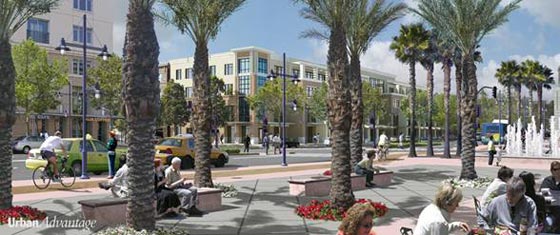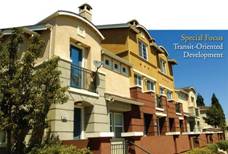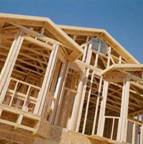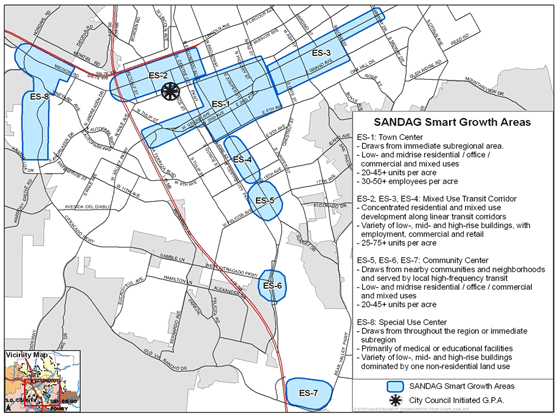
(Escondido Transit Center, SANDAG Smart Growth Visualization)
Updating Escondido's General Plan will involve including Smart Growth principles and policies that can be incorporated into future land use decisions. Following are frequently asked questions regarding Smart Growth and its role in Escondido's future.
1. What is Smart Growth?
Smart Growth is a planning doctrine that advocates compact, transit-oriented land use and the concentration of growth in the city's core. It encourages communities to take the wide view and prioritize long-term regional sustainability over short-term interests in order to prevent inefficient urban sprawl. The main elements of Smart Growth are:
Compact, Pedestrian- and Bicycle-Friendly Neighborhoods – Focus is placed on improving the quality of our neighborhoods. Balancing affordability, convenience, attractiveness, and safety creates a healthy environment, a sense of place, and a more livable community.
 Transit-Oriented Development – Previous land-use planning has placed housing far from jobs and services and placed heavy reliance on the automobile. Smart Growth advocates mixing uses and concentrating development near public transit in order to provide several convenient transportation options.
Transit-Oriented Development – Previous land-use planning has placed housing far from jobs and services and placed heavy reliance on the automobile. Smart Growth advocates mixing uses and concentrating development near public transit in order to provide several convenient transportation options.
Preserving Open Space – By encouraging infill development, Smart Growth aims to preserve natural resources while providing an attractive landscape, recreational facilities, cleaner air, and fresher drinking water.
Improving Existing Communities – Smart Growth focuses investment into areas where people live today. Improving roads, sewers, and services in existing communities, rather than constructing new developments in outlying areas, ensures that all residents benefit from prosperity in an equitable way.
2. What role does Escondido play in the regional Smart Growth plan?
In 2004 the San Diego Association of Governments (SANDAG) adopted the Regional Comprehensive Plan, establishing a framework for coordinating land use and transportation planning with the goal of concentrating regional growth into urban areas and Smart Growth communities. SANDAG has since created a Smart Growth Concept Map which identifies over 200 existing, planned, and potential Smart Growth areas in the region.
 The City of Escondido has several Smart Growth Opportunities; SANDAG has designated downtown Escondido as a "Town Center," and identified several potential mixed-use transit corridors along East Valley Parkway and Escondido Boulevard. Special-use centers such as the Escondido Research and Technology Center are included as well as area around the Nordahl Road Transit Station, future California High-Speed Rail Stop, and Westfield Shoppingtown. You can view Escondido's Smart Growth Opportunities (as well as other jurisdictions) on SANDAG’s interactive map.
The City of Escondido has several Smart Growth Opportunities; SANDAG has designated downtown Escondido as a "Town Center," and identified several potential mixed-use transit corridors along East Valley Parkway and Escondido Boulevard. Special-use centers such as the Escondido Research and Technology Center are included as well as area around the Nordahl Road Transit Station, future California High-Speed Rail Stop, and Westfield Shoppingtown. You can view Escondido's Smart Growth Opportunities (as well as other jurisdictions) on SANDAG’s interactive map.
Escondido is projected to add an additional 8,000 housing units by 2030. Determining where this growth should be delegated and ensuring adequate resources and infrastructure is available to meet future demand will be important for accommodating all residents. Concentrating future growth in Smart Growth Areas will be a step in ensuring Escondido's sustainability.
SANDAG has prepared several visual simulations of various locations around San Diego County (including Escondido) illustrating how Smart Growth concepts can transform a nondescript street or intersection into a vibrant and exciting environment. These simulations demonstrate how working with the existing development conditions and incorporating Smart Growth principles can make a positive impact regardless of the surrounding density or intensity. Click here to see additional examples of densities and land uses for projects approved and/or constructed in Escondido incorporating smart growth principles.
3. Why is Smart Growth important for San Diego County?
SANDAG's Regional Growth Forecast projects that the County's population will grow by over one million from 2000-2030, an increase of approximately 42%. Designating appropriate areas for future growth will be a key to retaining the region's desirability.
Assembly Bill 32, known as the California Global Warming Solutions Act of 2006, requires the state to reduce its greenhouse gas emissions to 1990 levels by the year 2020. Senate Bill 375 requires that regional transportation planning must measure and reduce Vehicle Miles Traveled (VMT) in order to help meet that goal.
 USD's San Diego County Greenhouse Gas Inventory and the San Diego Air Pollution Control District's Annual Report found that on-road transportation made up 46% of the region's greenhouse emissions, by far the largest category. Concentrating future growth into urban and town cores will effectively reduce the need for additional automotive infrastructure, lower regional greenhouse emissions, and help create healthier, more livable communities.
USD's San Diego County Greenhouse Gas Inventory and the San Diego Air Pollution Control District's Annual Report found that on-road transportation made up 46% of the region's greenhouse emissions, by far the largest category. Concentrating future growth into urban and town cores will effectively reduce the need for additional automotive infrastructure, lower regional greenhouse emissions, and help create healthier, more livable communities.
San Diego remains one of the most automobile-dependent regions in the country. Widening roads and building additional freeway lanes to accommodate sprawl development is costly and inefficient. SANDAG's Regional Transportation Plan and Pathways for the Future anticipate Smart Growth principles to be incorporated into land use planning as a means to reduce traffic congestion and reduce the need for expanding freeways.
A continuation of the development and transportation practices of the past will not effectively accommodate anticipated population increases. Developing land distant from services and job centers further damages the environment and compounds traffic congestion. Any reductions in greenhouse gas emissions achieved through fuel efficiency, an important component of AB 32, would be eliminated by an increased population driving greater distances more frequently.
4. How will Smart Growth principles be utilized in the General Plan Update?
Land Use as laid out in Escondido's current General Plan already supports "a balanced use of travel modes to address the transportation needs of all ages and to provide mobility for a variety of trip purposes." (II-67). It is also the goal of the City to "encourage a compact, efficient urban form which conserves land and other natural and environmental resources and which respects natural topography, drainage patterns and community character" and to "pursue the proper balance of housing and jobs." (II-80) These goals will be re-examined and strengthened in the upcoming General Plan Update in order to best meet the future needs of the City and its residents.
Areas on the map below have been identified as Escondido's Smart Growth Opportunities (click map to view larger image).
